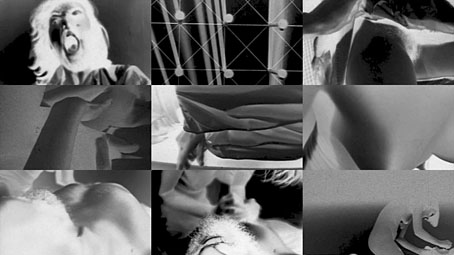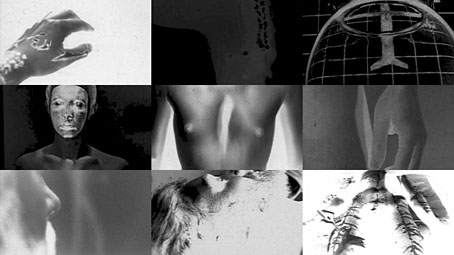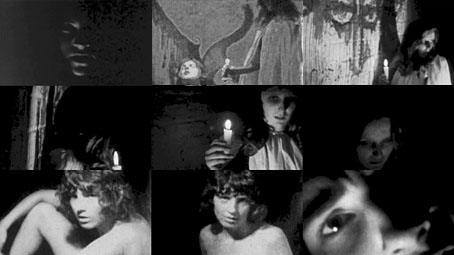The Forbidden.
Clive Barker announced late last month that arrangements were being made for a remake of Hellraiser. This isn’t the first time such an announcement has been made so we’ll have to wait and see what comes of that. I think I’m in a minority of people who’ve always been well-disposed to Barker and his works (the early stories in particular) but have never really enjoyed Hellraiser. I saw it when it was first released, and was disappointed that Barker and co. hadn’t manage to successfully negotiate the pitfalls of making a British film for demanding American producers. The soundtrack that Barker commissioned from Coil was dropped (a serious error); the film’s awkward mid-Atlantic tone makes suspension of disbelief difficult, and considering Barker’s success as a storyteller the narrative is often confused and disjointed. Without all the memorable imagery it’s doubtful it would have had much of a lasting reputation, or birthed so many sequels.
The Forbidden.
Barker and his theatre colleagues made The Forbidden in 1978, a 35-minute 16mm film of entirely negative images which shows how different Hellraiser might have been if fewer capitulations had been made to the marketplace, and to the clichés of horror cinema. Both films concern an occult ritual, an occult puzzle, and the subsequent consequences of the ritual. Where Hellraiser has to connect its most striking scenes with mundane business such as Julia’s murder spree and screaming teens, The Forbidden presents its imagery as raw data, leaving it to the viewer to piece together its fragments.
Barker’s work since Hellraiser has been almost completely generic so it’s surprising to see something of his that’s this open and abstract. In tone it’s closer to the films of Derek Jarman or Kenneth Anger than anything else, especially the sequence of Barker himself dancing with an erection, something which will ensure this doesn’t get many TV screenings. (Barker has referred to Kenneth Anger when discussing the film.) The final section, featuring a man being lovingly flayed by a number of scalpel-wielding hands, offers the same spectacle as Hellraiser‘s skinless Frank but without any of the accompanying frenzy. This won’t necessarily be on YouTube for very long so watch it while you can. The uploaded version is from the Redemption DVD, music included. Since the film is silent you can watch it with a score of your choice; I’d suggest Coil’s themes for Hellraiser.
Salome.
Where The Forbidden is a successful piece of avant-garde cinema, Barker’s 17-minute dramatisation of Salome (1973) is closer to a well-made home movie. This is silent as well, and even has the quality and feel of a very old silent film. For an amateur work it still manages to convey a greater sense of dread than some of the other Salomé-related films which have been featured here, and I believe that’s the director himself playing the femme fatale.
Elsewhere on { feuilleton }
• The Salomé archive
Previously on { feuilleton }
• Clive Barker, Imaginer




I’ve been a big Barker kick lately, prompted to a large degree by nostalgia. Looking back at his work for the first time probably since my teens, I think there’s merit in a lot of it. The movies he’s been involved with as a producer are certainly generic, but I don’t know if that’s completely fair to say of his directorial work. His films as a director are all quite flawed, but always interesting and imaginative; Alejandro Jodorowsky, for example, apparently admired Nightbreed, calling it the first truly gay horror fantasy epic. That’s how it always played to me, as a Cocteau-like fantasia of being initiated into a carnivalesque, night-time subculture, the effect only undone by a terribly overblown and over-loud finale. Similarly, Lords of Illusions, probably the weakest of his films, is nevertheless interesting in that it seems to be at heart the story of an older man’s jealousy and possessiveness towards a young lover. Very imperfect films certainly, but I think Barker’s attempt to marry more countercultural images and ideas with populist forms, as in his writing, is an admirable effort.
I remember seeing an edited version of The Forbidden late night on the SciFi channel back in the mid nineties. They might have aired Salome too but I can’t be sure. Barker even introduced the film with a little commentary. Blew my adolescent mind.
Tristan: My use of the word “generic” isn’t intended as a negative, merely a description of something which fits a genre, in this case horror. Much of my own work is generic in the same way. The Forbidden is interesting because it’s not generic in that sense at all, it’s more an unusual art film–and as I say above–it shows how Barker’s work could easily have developed in a different direction.
That wasn’t what he wanted, of course, but he’s a curious and rare example of someone sitting happily at the centre of the horror and fantasy genres who has always been very aware of (and borrowed from) things a long way outside those genres.
I’ve still not seen Lord of Illusions. The story that was based on was a favourite of mine, and the reports of the film were so bad I kept away from it.
Lord of Illusions isn’t really a great film, but I own it and would say that its use of special effects and imagery alone make it well-worth viewing. There was a point in the nineties before leaning on excessive computer-aided animation became terribly commonplace where people with an eye for such things would often combine some of the most sophisticated manner of set pieces, make-up/prosthetic artwork, and trick photography and weave this all-together with varying results. LOL, oops, nevermind, I am not going to delete that, was one of the better. Though the story-to-film translation wasn’t terribly graceful, on a technical level, I’d definitely say its worth the time. Its a more mainstream showcase of Barker’s oft-overlooked painterly talents more deeply investigated with his earlier theater works. Don’t let the late but by no means great Mr. Ebert discourage you.
I was never drawn to the commercial films of Clive Barker. Clearly there were intriguing ideas embedded in them, but the end products were invariably uncomfortably stitched together. (The finale of Nightbreed was just unwatchable!)
But here, in the early films John has directed us to at Youtube, we see something so much more interesting. Without digital special effects or a massive prosthetics budget, Barker conjures a poetic unease, a glass-boned chill that I find so much more engaging than the slice-and dice of Hellraiser. (The flayed corpse standing and looking directly into the camera is riveting, not least because the negative footage renders it rather beautiful.) Blown away by this.
There are lessons to be learned here. Barker clearly had a unique vision, but a lot of it was lost when shoehorned into far more commercial products.
Clive: The attraction of the horror genre for writer and audience is obviously the visionary elements. The problems occur when trying to present those elements in a narrative form. This is why ghost and horror stories often work better in the smaller space of the short story; at novel and film length you quickly get bogged down with poor characterisation, hackneyed storylines and a version of the real world which isn’t properly realised in the rush to the next juicy scene.
Barker’s films have also been blighted by unsympathetic producers, something which happens so regularly you have to wonder why he keeps teaming up with these awful people. David Cronenberg has always been smart enough to seek out equally smart producers like Jeremy Thomas who specialise in bringing difficult films to the screen. Barker would say he’s always been going for the bigger audience but you don’t get much of an audience at all if your film is chopped about by the studio then released as a slasher film, as Nightbreed was.